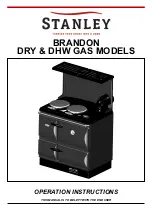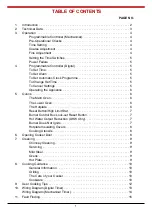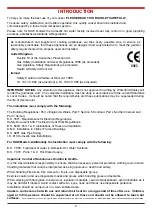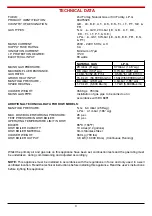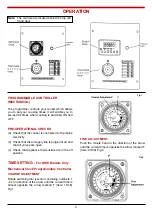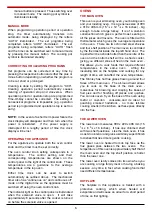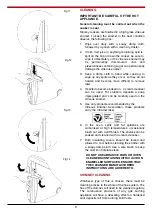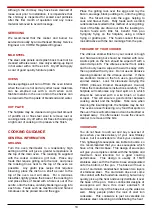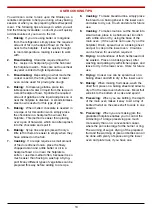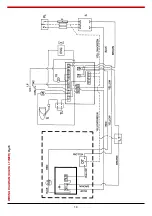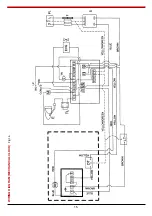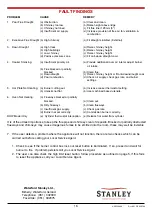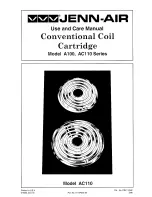
manual button is pressed. Thus switching over
to manual mode. The cooking pot symbol is
illuminated steadily.
MANUAL MODE
When programming operation period or operation
stop, the timer automatically transfers into
automatic mode, being displayed by the letters
“AUTO” illuminated. The set programs being
completed, letters “AUTO” illuminated. The set
programs being completed, letters “AUTO” flash
and the time can be switched over to manual mode
by pressing the manual button. The cooking pot
symbol is illuminated steadily.
CORRECTING OR CLEARING PROGRAMS
Set programs can be corrected at any time by
pressing the respective button and either the plus or
minus button depending on whether the program is
to be cut short or prolonged.
Clearing is done by setting the program to “0.00”.
Clearing operation period automatically causes
clearing of operation stop and vice-versa. When
operation period or operation stop are programmed
Time-Of-Day cannot be corrected. The setting of
nonsensical programs is impossible (e.g. operation
period is programmed and operation stop is set too
early).
NOTE:
In the event of a short term power failure the
clock display will disappear and then turn when the
power is reinstated. If the power supply is
interrupted for a lengthy period of time the clock
display will be lost.
OPERATING THE APPLIANCE
For the appliance to operate both the oven control
knob and the timer must be set correctly.
The oven control knob setting corresponds to a
temperature. The control setting and their
corresponding temperatures are shown on the
control panel to the right of the control knob. These
temperatures are a guideline to the average
temperature in the top oven.
Either time clock can be used to switch
automatically as outlined above. The mechanical
timer also has “continuous on” and continuous off”
mode on the digital time so the appliance must be
switched off using the oven control knob.
The indicator light on the control panel is illuminated
when the solenoid valve is open. It will take
approximately 8 seconds after the cooker is turned
on before the solenoid valve is opened.
OVENS
THE MAIN OVEN
This oven is your simmering oven, your baking oven
and your roasting oven. It is a generous size of 390
x 310 x 406 mm (15
1
/4
x 12
1
/4
x 16 inches) - big
enough to take a large turkey. It is of a cast-iron
construction which gives a perfect roast, sealing in
all the juices and flavours. The oven is fitted with a
thermometer which gives the average temperature
in the oven. There are two chromed steel shelves
and four shelf positions. The main oven is controlled
by the thermostat inside the top left hand door. The
top shelf will be a shade hotter than the centre of the
oven and the bottom shelf will be a shade cooler,
giving you different zones of heat in the main oven -
this allows you to cook foods that require different
temperatures in the same oven. Lifting the
insulating lids on the hotplate and cooking for any
length of time, will not affect the oven temperature.
The Stanley has hot flue gases flowing around four
faces of the main oven. The all-round heat allows
you to cook on the base of the main oven -
marvellous for browning and crisping the bases of
fruit pies and for finishing off pizzas and quiches.
You can also oven fry on the base of the oven using
metal or cast-iron cookware,and its ideal for
poaching smoked hadddock - no more tell-tale
cooking smells in the kitchen, as these pass directly
into the flue.
THE LOWER OVEN
The lower oven measures 390 x 220 x 406 mm (15
1
/4
x 8
3
/4
x 16 inches). It has one chromed shelf
with two shelf positions. Like the main oven, it has
a cast-iron interior and gives a similarly superb finish
to dishes that need more gentle cooking.
The lower oven is heated from its top face as the
flue gases pass between the two ovens. The
temperature of this oven is approximately half that of
the main oven and the top shelf position is hotter
than the lower one.
The lower oven really comes into its own when you
are cooking a large family meal or having a baking
session - any time, in fact, when cooking foods that
need different temperatures.
HOTPLATE
The hotplate in this appliance is treated with a
protective coating, which when heated will
evaporate and will cause an odour for a short period
of time on first lighting.
6

